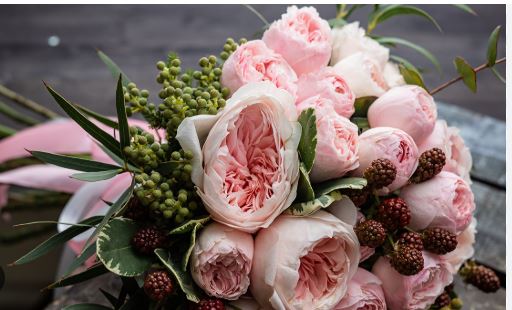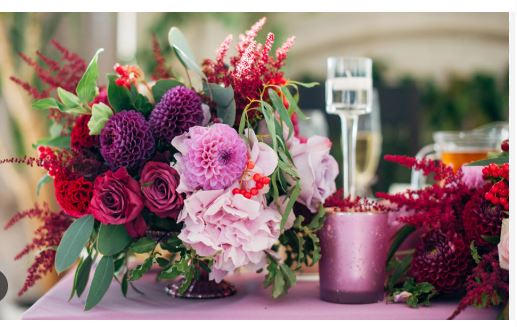
Wedding flowers are a cornerstone of matrimonial decor, adding beauty, fragrance, and symbolism to ceremonies and receptions. Chosen for their aesthetic appeal, they enhance venues with vibrant colors or soft elegance, complementing themes from rustic to luxurious. Their versatility allows them to be crafted into bouquets, centerpieces, or accents, creating a cohesive atmosphere.
The selection of wedding flowers often reflects the couple’s personality and season of the event. Spring and summer weddings favor lighter, pastel blooms, while fall and winter call for richer tones or evergreens. Seasonal availability ensures freshness and can reduce costs, aligning with budget considerations.
Symbolism plays a key role in choosing wedding flowers, as many carry meanings like love, purity, or fidelity. These symbolic elements add emotional depth, making arrangements more than just decor. Couples often select blooms that resonate with their relationship or cultural traditions.
Practical considerations, such as durability and fragrance, guide flower choices. Long-lasting blooms withstand hours of display, while scented varieties add charm but must be balanced to avoid overwhelming guests. Consulting with a florist helps match flowers to the venue and climate.
Budget and scale influence flower arrangements, with options ranging from lavish displays to minimalist accents. Combining focal blooms with affordable fillers maximizes impact without overspending. Careful planning ensures flowers enhance the wedding’s ambiance while staying practical.

Wedding Flowers
Rose
- Appeal: Known as the ultimate symbol of love, roses offer a classic, romantic look with a wide range of colors (red, white, pink, etc.).
- Uses: Used in bouquets, boutonnieres, and centerpieces due to their timeless elegance and durability.
- Symbolism: Love, passion, and devotion, making them a staple for wedding romance.
Peony
- Appeal: Lush, full blooms in soft shades like blush, pink, and white create a luxurious, romantic vibe.
- Uses: Popular in bouquets and large arrangements, often paired with greenery for a lush effect.
- Symbolism: Prosperity, honor, and a happy marriage, ideal for bridal settings.
Ranunculus
- Appeal: Delicate, layered petals in vibrant or pastel hues add a whimsical, garden-like charm.
- Uses: Common in bouquets and table decor, blending well with other soft blooms like roses.
- Symbolism: Charm and attractiveness, perfect for expressing admiration.
Tulip
- Appeal: Sleek, elegant stems in colors like white, pink, and red offer a clean, modern look.
- Uses: Used in minimalist bouquets or mixed arrangements for spring weddings.
- Symbolism: Perfect love and affection, aligning with wedding themes.
Hydrangea
- Appeal: Large, voluminous clusters in blue, pink, or white add texture and fill space beautifully.
- Uses: Ideal for centerpieces and arch decor due to their size and lush appearance.
- Symbolism: Gratitude and heartfelt emotions, fitting for wedding gratitude.
Gardenia
- Appeal: Creamy white petals and a sweet fragrance create an elegant, vintage feel.
- Uses: Often used in bridal bouquets, corsages, or as floating blooms in centerpieces.
- Symbolism: Purity, love, and refinement, enhancing wedding sophistication.
Lily
- Appeal: Dramatic, trumpet-shaped blooms in white, pink, or yellow offer bold elegance.
- Uses: Featured in bouquets or as focal points in arrangements for a regal touch.
- Symbolism: Purity, fertility, and renewal, resonating with new beginnings.
Orchid
- Appeal: Exotic, sleek blooms in white, purple, or pink add a modern, luxurious flair.
- Uses: Used in cascading bouquets, boutonnieres, or as accents in tropical-themed weddings.
- Symbolism: Beauty, strength, and love, ideal for unique wedding aesthetics.
Baby’s Breath
- Appeal: Delicate, airy white or pink clusters add a soft, ethereal texture to arrangements.
- Uses: Common as a filler in bouquets, centerpieces, or as standalone decor for rustic weddings.
- Symbolism: Everlasting love and innocence, complementing romantic themes.
Dahlia
- Appeal: Bold, intricate blooms in vibrant or pastel shades bring drama and variety.
- Uses: Focal flower in bouquets or centerpieces, especially for fall or bohemian weddings.
- Symbolism: Dignity and commitment, reflecting enduring partnerships.
Sweet Pea
- Appeal: Dainty, fragrant blooms in pastel colors like pink, lavender, and white exude charm.
- Uses: Perfect for vintage or garden-style bouquets and delicate table settings.
- Symbolism: Blissful pleasure and gratitude, evoking joy in weddings.
Calla Lily
- Appeal: Sleek, sculptural blooms in white, pink, or deep purple offer modern elegance.
- Uses: Popular in minimalist bouquets or as statement pieces in tall arrangements.
- Symbolism: Purity and magnificence, ideal for sophisticated ceremonies.
Carnation
- Appeal: Affordable, long-lasting blooms in a wide color range add versatility and charm.
- Uses: Used in bouquets, corsages, or garlands, especially for budget-conscious weddings.
- Symbolism: Love, fascination, and devotion, with colors carrying specific meanings (e.g., red for deep love).
Stephanotis
- Appeal: Small, star-shaped white flowers with a sweet scent offer delicate, classic beauty.
- Uses: Often used in bridal bouquets, corsages, or hairpieces for a traditional look.
- Symbolism: Marital happiness, making it a traditional wedding flower.
Anemone
- Appeal: Striking black centers with white or colorful petals (pink, purple) offer a bold, modern look.
- Uses: Used in bouquets or centerpieces, often for winter or dramatic weddings.
- Symbolism: Anticipation and protection, fitting for new beginnings.
Chrysanthemum
- Appeal: Full, vibrant blooms in various colors (white, yellow, pink) add texture and affordability.
- Uses: Common in centerpieces or as fillers in mixed arrangements for fall weddings.
- Symbolism: Longevity and joy, symbolizing a lasting marriage.
Freesia
- Appeal: Delicate, fragrant blooms in white, pink, or yellow bring a soft, romantic charm.
- Uses: Ideal for bouquets, corsages, or table decor due to their sweet scent.
- Symbolism: Innocence and friendship, reflecting trust in relationships.
Gladiolus
- Appeal: Tall spikes of vibrant flowers (red, pink, white) add height and drama.
- Uses: Used in arch decor or tall centerpieces for elegant, structured designs.
- Symbolism: Strength and integrity, representing a strong partnership.
Lisianthus
- Appeal: Rose-like blooms in soft shades (white, pink, lavender) offer a delicate, elegant look.
- Uses: Popular in bouquets and arrangements for their long-lasting nature.
- Symbolism: Appreciation and charisma, enhancing wedding gratitude.
Daisy
- Appeal: Simple, cheerful white or yellow blooms create a rustic, carefree vibe.
- Uses: Used in casual bouquets or wildflower-inspired decor for outdoor weddings.
- Symbolism: Innocence and purity, evoking youthful love.
Alstroemeria
- Appeal: Colorful, lily-like blooms (pink, orange, white) add vibrancy and durability.
- Uses: Common in bouquets or mixed arrangements for their long vase life.
- Symbolism: Devotion and friendship, ideal for celebrating bonds.
Delphinium
- Appeal: Tall, vibrant blue or white spikes add a bold, vertical element.
- Uses: Used in backdrops, arches, or centerpieces for a pop of color.
- Symbolism: Openness and love, aligning with wedding celebrations.
Snapdragon
- Appeal: Spiky blooms in pink, white, or yellow offer a whimsical, garden-like feel.
- Uses: Featured in bouquets or tall arrangements for cottage-style weddings.
- Symbolism: Grace and strength, reflecting a resilient partnership.
Protea
- Appeal: Exotic, large blooms in pink or white add a unique, tropical flair.
- Uses: Focal point in bouquets or centerpieces for bohemian or destination weddings.
- Symbolism: Transformation and courage, symbolizing bold love.
Lavender
- Appeal: Fragrant purple sprigs add a rustic, aromatic touch to decor.
- Uses: Used in bouquets, boutonnieres, or as table accents for lavender-themed weddings.
- Symbolism: Serenity and devotion, promoting calm and love.
Amaranth
- Appeal: Feathery, vibrant heads (red, pink) add texture and a bohemian vibe.
- Uses: Used in cascading bouquets or as accents in eclectic arrangements.
- Symbolism: Immortality and everlasting love, perfect for weddings.
Zinnia
- Appeal: Bright, bold blooms in various colors (red, pink, yellow) add cheer and vibrancy.
- Uses: Popular in summer bouquets or rustic centerpieces for colorful weddings.
- Symbolism: Lasting affection and remembrance, celebrating enduring love.
Cosmos
- Appeal: Airy, daisy-like blooms in pink, white, or red offer a delicate, wildflower charm.
- Uses: Used in bouquets or scattered in decor for garden or outdoor weddings.
- Symbolism: Harmony and peace, reflecting a balanced marriage.
Stock
- Appeal: Fragrant, clustered blooms in pastel shades (pink, white, lavender) add a soft, romantic touch.
- Uses: Used in bouquets or centerpieces for their scent and full appearance, ideal for vintage weddings.
- Symbolism: Lasting beauty and a happy life, aligning with marital bliss.
Sunflower
- Appeal: Bold, cheerful yellow blooms bring warmth and a rustic, joyful vibe.
- Uses: Featured in bouquets or centerpieces for summer or countryside weddings.
- Symbolism: Adoration and loyalty, reflecting a devoted partnership.
Camellia
- Appeal: Lush, rose-like blooms in white, pink, or red offer timeless elegance.
- Uses: Used in bridal bouquets or as accents in winter or classic wedding decor.
- Symbolism: Gratitude and admiration, perfect for expressing love.
Jasmine
- Appeal: Small, fragrant white flowers add a delicate, aromatic charm.
- Uses: Woven into hairpieces, bouquets, or garlands for romantic or tropical weddings.
- Symbolism: Love and purity, enhancing wedding intimacy.
Veronica
- Appeal: Slender spikes of tiny flowers in white, pink, or blue add height and texture.
- Uses: Used as a filler in bouquets or arrangements for a delicate, airy look.
- Symbolism: Fidelity and healing, symbolizing a strong bond.
Aster
- Appeal: Star-shaped blooms in purple, pink, or white offer a dainty, whimsical feel.
- Uses: Common in wildflower bouquets or centerpieces for garden-style weddings.
- Symbolism: Love and patience, fitting for enduring relationships.
Phlox
- Appeal: Clusters of vibrant flowers (pink, white, purple) create a lush, colorful effect.
- Uses: Used in bouquets or border arrangements for summer or cottage weddings.
- Symbolism: Harmony and partnership, reflecting marital unity.
Gypsophila (Baby’s Breath Alternative Varieties)
- Appeal: Tiny, cloud-like blooms in white or pink add a soft, ethereal texture.
- Uses: Used as a standalone decor or filler in bouquets for rustic or minimalist weddings.
- Symbolism: Everlasting love, complementing wedding themes.
Tuberose
- Appeal: Fragrant, creamy white blooms offer a luxurious, exotic scent and look.
- Uses: Featured in bouquets or centerpieces for evening or tropical weddings.
- Symbolism: Passion and deep love, evoking romantic intensity.
Scabiosa
- Appeal: Delicate, pincushion-like blooms in white, lavender, or burgundy add a charming, textured look.
- Uses: Used in bouquets or arrangements for bohemian or vintage weddings.
- Symbolism: Love and purity, aligning with wedding sentiments.
General Tips for Wedding Flowers
- Seasonality: Choose flowers available during your wedding season to ensure freshness and cost-effectiveness (e.g., peonies in spring, dahlias in fall).
- Color Coordination: Match flowers to your wedding palette, mixing bold and soft blooms for balance (e.g., roses with baby’s breath).
- Budget: Combine expensive blooms (e.g., orchids) with cost-effective fillers (e.g., carnations, baby’s breath) to stretch your budget.
- Allergies: Opt for low-pollen flowers like roses or orchids to minimize allergic reactions for guests.